Influence of Edge-Limited Hot Surfaces on Accidental Ignition and Combustion in Ship Engine Rooms: A Case Study of Marine Diesel Leakage
Abstract
1. Introduction
2. Materials and Method
2.1. Experimental Marine Diesel and Arrangement
2.2. Heat Transfer and Ignition Mechanism of Leaking Marine Fuel on Hot Surface
3. Results and Discussion
3.1. Effect of Edge Structure on Diesel HSI Position with Varying Leakage Rate
3.2. Edge-Limitied HSI Position of Marine Fuel for Elevated HSTs
3.3. Influence of Edge Structure on Ignition Delay Time of Marine Diesel Leakage
3.4. Flame Spread of Leaking Marine Fuel above Hot Surface Edge Structure
4. Conclusions
- The presence of edge structures on hot surface affects the plume swirling process, which in turn exerts influence on the flow state of a plume. The varying combustion patterns and turbulence of plumes on hot surface impact the radiative and convective thermal feedback effects of the flame on marine diesel.
- HSI position is influenced by edged hot surfaces, causing the vertical centerline to shift towards the edge structure. Equation (9) is a prediction model for determining HSI height of marine diesel for varying leakage flow rates. Equation (11) was developed to evaluate the occurrence of diesel HSI in cases of leakage based on monitored HST, which is crucial for preventing initial ignition.
- Ignition delay time of diesel leakage on edged hot surfaces decreases as the leakage flow rate increases. This change causes the initial HSI of gaseous mixtures to occur earlier, potentially creating new fire hazards in ship engine rooms. In the event of significant leakage from a piping system, the time required for diesel leakage HSI on edge-limited surfaces is reduced.
- Unstable plumes gradually descend to a position near the hot surface and begin to tumble and expand upward. This phenomenon occurs due to a puffing motion, which accelerates the mixing of HSI-driven vapors with the engine room’s air. Puffing motion is affected by edged hot surfaces and is also correlated with the HST.
Author Contributions
Funding
Institutional Review Board Statement
Informed Consent Statement
Data Availability Statement
Acknowledgments
Conflicts of Interest
Nomenclature
| A | Surface cross-sectional area, m |
| ag,n | Gray gas weighting coefficient |
| Cp,l | Specific heat of liquid fuel, kJ/(kg·K) |
| D | Diameter of pool’s side length, m |
| E | Evaporation rate, kg/(m2·s) |
| Fb | Configuration factor |
| Hmax | Maximum HSI height, m |
| Have | Mean HSI height of diesel on edge-limited surface, m |
| Hfg | Latent heat of vaporization, J/(kg∙K) |
| hF | Heat transfer coefficient of film boiling mode, W/(m2·K) |
| hn | Heat transfer coefficient of nuclear boiling mode, W/(m2·K) |
| kg,n | Absorption coefficient, Pa−1·m−1 |
| L | Path length, m |
| mb | Area-specific mass burning rate, kg/(m2·s) |
| mf | Evaporation mass of liquid fuel, kg/(m2·s) |
| p | Partial pressure, Pa |
| qfs | Heat flux received by the fuel surface, kW/m2 |
| qc0 | Dominant heat feedback being by convection, kW |
| qr0 | Dominant heat feedback being by radiation, kW |
| Qrad | Radiation from heat transfer to lower half of liquid surface, W/(m·K) |
| Rrad | Radial direction, m |
| r | Radius of liquid droplet, m |
| S | Stoichiometric air-to-fuel mass ratio |
| Tsat | Saturation temperature, K |
| Ts | Hot-surface temperature, K |
| Tf | Temperature of liquid fuel, K |
| t | Time scale, s |
| ∆Hg | Heat of gasification of combustible fuel, kJ/kg |
| ∆Hch | Chemical heat of combustion, kJ/kg |
| εm | Total emissivity of soot/CO2/H2O mixtures |
| ρv | Fuel vapor density, kg/m3 |
| μvf | Viscosity of vapor in the film between wall and liquid, Pa∙s |
| Ys | Smoke yield (mass of smoke/mass of fuel) |
| λ | Latent heat of liquid fuel, kJ/kg |
| σ | Stefan-Boltzmann constant |
References
- Li, N.; Zhang, B.; Liu, X.; Wang, K.; Wang, H. Experimental research and numerical analysis of marine oil leakage and accidental ignition in fishing vessels. Appl. Sci. 2023, 13, 11510. [Google Scholar] [CrossRef]
- Zhang, H.; Li, C.; Zhao, N.; Chen, B.-Q.; Ren, H.; Kang, J. Fire risk assessment in engine rooms considering the fire-induced domino effects. J. Mar. Sci. Eng. 2022, 10, 1685. [Google Scholar] [CrossRef]
- Li, C.; Zhang, H.; Zhang, Y.; Kang, J. Fire risk assessment of a ship’s power system under the conditions of an engine room fire. J. Mar. Sci. Eng. 2022, 10, 1658. [Google Scholar] [CrossRef]
- Wang, C.; Qian, C.; Liu, J.N.; Liberman, M.A. Influence of chemical kinetics on detonation initiating by temperature gradients in methane/air. Combust. Flame 2018, 197, 400–415. [Google Scholar] [CrossRef]
- Zeldovich, Y.B.; Barenblatt, G.I.; Librovich, V.B.; Makhviladz, G.M. The Mathematical Theory of Combustion and Explosions; Springer: New York, NY, USA, 1985. [Google Scholar]
- Siriganano, W.; Merzhabov, A.; De Luca, L. Advances in Combustion Science in Honor of Ya. B. Zelovich; Progress in Astronautics and Aeronautics; AIAA: Cambridge, MA, USA, 1996; Volume 173. [Google Scholar]
- Zeldovich, Y.B. Regime classification of an exothermic reaction with nonuniform initial conditions. Combust. Flame 1980, 39, 211–214. [Google Scholar] [CrossRef]
- Owrutsky, J.C.; Steinhurst, D.A.; Minor, C.P.; Rose-Pehrsson, S.L.; Williams, F.W.; Gottuk, D.T. Long wavelength video detection of fire in ship compartments. Fire Saf. J. 2006, 41, 315–320. [Google Scholar] [CrossRef]
- Su, S.; Wang, L. Three dimensional reconstruction of the fire in a ship engine room with multilayer structures. Ocean. Eng. 2013, 70, 201–207. [Google Scholar] [CrossRef]
- Wu, B.; Zong, L.; Yip, T.L.; Wang, Y. A probabilistic model for fatality estimation of ship fire accidents. Ocean Eng. 2018, 170, 266–275. [Google Scholar] [CrossRef]
- Spyrou, K.J.; Koromila, I.A. A risk model of passenger ship fire safety and its application. Reliab. Eng. Syst. Saf. 2020, 200, 106937. [Google Scholar] [CrossRef]
- Liu, W.; Wang, L.; Su, S.; Wu, Z.; Guo, Y.; Du, K. Study of the flame flow and combustion characteristics of pool fires around a bluff body in the ship engine room. Case Stud. Therm. Eng. 2021, 28, 101514. [Google Scholar] [CrossRef]
- Wang, L.; Guo, Y.; Xia, Z.; Lao, X.; Su, S.; Yuan, Z.; Wu, Z. Experimental study on mass burning rate and flame geometry of pool fires under two-way indirect ventilation in Ship’s engine room. Case Stud. Therm. Eng. 2023, 41, 102595. [Google Scholar] [CrossRef]
- Wu, J.; Du, Z.; Yan, M.; Sun, X. Assessment of ship hull ultimate strength under fire conditions: The fire smith method approach. J. Mar. Sci. Eng. 2023, 11, 2055. [Google Scholar] [CrossRef]
- Wu, G.; Li, J.; Guo, H.; Wang, X.; Jiang, G. Numerical method for predicting emissions from biodiesel blend fuels in diesel engines of inland waterway vessels. J. Mar. Sci. Eng. 2023, 11, 86. [Google Scholar] [CrossRef]
- Yuan, J.; Zhao, J.; Wang, W.; Yang, R.; Chen, C.; Fu, M. The study of burning behaviors and quantitative risk assessment for 0# diesel oil pool fires. J. Loss Prev. Process Ind. 2021, 72, 104568. [Google Scholar] [CrossRef]
- Leite, R.M.; Centeno, F.R. Effect of tank diameter on thermal behavior of gasoline and diesel storage tanks fires. J. Hazard. Mater. 2018, 342, 544–552. [Google Scholar] [CrossRef] [PubMed]
- Manescau, B.; Wang, H.; Coudour, B.; Garo, J.P. Influence of heat tightness of an enclosure fire on ignition risk of unburnt gases in a connected exhaust system–An experimental study. Fire Saf. J. 2019, 109, 102867. [Google Scholar] [CrossRef]
- Manescau, B.; Courty, L.; Acherar, L.; Coudour, B.; Wang, H.; Garo, J. Effects of ventilation conditions and procedures during a fire in a reduced-scale room. Process Saf. Environ. Prot. 2020, 144, 263–272. [Google Scholar] [CrossRef]
- Veritas, D.N. Engine Room Fires Can Be Avoided; DNV: Veritasveien, Norway, 2000. [Google Scholar]
- Baalisampang, T.; Abbassi, R.; Garaniya, V.; Khan, F.; Dadashzadeh, M. Review and analysis of fire and explosion accidents in maritime transportation. Ocean Eng. 2018, 158, 350–366. [Google Scholar] [CrossRef]
- Chen, J.; Wang, D.; Guo, L.; Wang, Z.; Kong, D. Experimental study on flame morphology and flame radiation of pool fire sheltered by plate obstacle. Process Saf. Environ. Prot. 2022, 159, 243–250. [Google Scholar] [CrossRef]
- Wu, H.; Cao, W.; Li, H.; Shi, Z.; Diao, Y.; Zhang, L.; Bo, Y.; Li, X. Study on impinging ignition and wall-attached fuel film combustion characteristics of light- to heavy-duty diesel engines at low temperatures. Fuel 2022, 313, 123065. [Google Scholar] [CrossRef]
- Wang, K.; Zhou, Z.; Ming, Y.; Qian, X. Research on hot surface ignition characteristics of leaking fuel in ship engine room. Therm. Sci. 2023, 27, 2813–2829. [Google Scholar] [CrossRef]
- Tang, W.; Bahrami, D.; Yuan, L.; Thomas, R.; Soles, J. Hot surface ignition of liquid fuels under ventilation. Mining. Metall. Explor. 2022, 39, 961–968. [Google Scholar] [CrossRef]
- Wang, Z.; Chen, J.; Yu, Y.; Kong, D. Experimental study on the ignition and burning characteristics of liquid fuels on hot surfaces. Process Saf. Environ. Prot. 2023, 176, 725–733. [Google Scholar] [CrossRef]
- Robinet, A.; Chetehouna, K.; Junjunan, K.; Cablé, A.; Oger, A. Thermal and spectral analysis of a pool fire in an engine compartment: Experimental study on the influence of ventilation and fuel depth. Process Saf. Environ. Prot. 2023, 174, 200–213. [Google Scholar] [CrossRef]
- Zhang, S.; Fang, W.; Shi, L.; Liu, J.; Liu, J.; Wang, J.; Cong, B. Fire plume characteristics of annular pool fire with different cylindrical obstacles in a ship engine room. Ocean Eng. 2023, 276, 114253. [Google Scholar] [CrossRef]
- Hong, M.; Merci, B.; Beji, T. Numerical simulations of oscillatory combustion and extinction of a liquid pool fire in a reduced-scale and mechanically-ventilated enclosure. Fire Saf. J. 2023, 141, 104005. [Google Scholar] [CrossRef]
- Lafdal, B.; Mehaddi, R.; Boulet, P.; Koutaiba, E.; Beji, T. Oscillatory burning regime in a gas-fueled compartment fire. Fire Saf. J. 2024, 142, 104045. [Google Scholar] [CrossRef]
- Wang, K.; Ming, Y.; Wang, H.; Liu, X.; Qian, X.; Shi, T. Failure analysis and correction models for upward flame characteristics subjected to shipping container fire. Eng. Fail. Anal. 2023, 152, 107519. [Google Scholar] [CrossRef]
- Wang, Z.; Paulauskiene, T.; Uebe, J.; Bucas, M. Characterization of Biomethanol–Biodiesel–Diesel Blends as Alternative Fuel for Marine Applications. J. Mar. Sci. Eng. 2020, 8, 730. [Google Scholar] [CrossRef]
- Wang, K.; Ming, Y.; Liu, X.; Wang, H.; He, Y. Effect of lateral airflow on initial HSI and flame behavior of marine fuel in a ship engine room: Experiment and analysis. J. Mar. Sci. Eng. 2024, 12, 5. [Google Scholar] [CrossRef]
- Mizomoto, M.; Ikai, S.; Morita, A. Evaporation and ignition of a fuel droplet on a hot surface (Part 4, model of evaporation and ignition). Combust. Flame 1983, 51, 95–104. [Google Scholar] [CrossRef]
- Mizomoto, M.; Masuda, I.; Ikai, S. Combustion of a coal-oil mixture droplet on a hot surface. Combust. Flame 1986, 63, 289–301. [Google Scholar] [CrossRef]
- Gülder, Ö.L.; Wong, J.K.S. Spheroidal evaporation and ignition of fuel droplets on a hot surface. Symp. (Int.) Combust. 1985, 20, 1751–1760. [Google Scholar] [CrossRef]
- Afgan, N.H.; Beér, J.M. Heat Transfer in Flames; John Wiley Sons: Washington, DC, USA, 1974. [Google Scholar]
- Taylor, P.B.; Foster, P.J. The total emissivities of luminous and non-luminous flames. Int. J. Heat Mass Transf. 1974, 17, 1591–1605. [Google Scholar] [CrossRef]
- Hu, L.H. A review of physics and correlations of pool fire behavior in wind and future challenges. Fire Saf. J. 2017, 91, 41–55. [Google Scholar] [CrossRef]
- Johnson, A.M.; Roth, A.J.; Moussa, N.A. Hot-Surface Ignition Tests of Aircraft Fluids; Final Report; Boeing Advanced Systems Co.: Seattle, WA, USA, 1988. [Google Scholar]
- Bennett, J.M. Literature Review of Mechanisms of Droplet/Spray Ignition by Hot Surfaces; Department of Mechanical and Aerospace Engineering, University of Dayton: Dayton, Dayton, OH, USA, 1998. [Google Scholar]
- Bennett, J.M. Ignition of Combustible Fluids by Heated Surfaces. Ph.D. Thesis, University of Dayton, Dayton, OH, USA, 2003. [Google Scholar]
- Karasawa, T.; Shiga, S.; Kurabayashi, T. Inition phenomenon of a fuel-droplet impinging upon a hot surface. JSME Int. J. Ser. B-Fluids Therm. Eng. 1986, 29, 143–148. [Google Scholar] [CrossRef]
- Tohidi, A.; Kaye, N.B. Highly buoyant bent-over plumes in a boundary layer. Atmos. Environ. 2016, 131, 97–114. [Google Scholar] [CrossRef]
- Babrauskas, V. Ignition of gases, vapors, and liquids by hot surfaces. Fire Technol. 2022, 58, 281–310. [Google Scholar] [CrossRef]
- Colwell, J.D.; Reza, A. Hot surface ignition of automotive and aviation fluids. Fire Technol. 2005, 41, 105–123. [Google Scholar] [CrossRef]
- Shaw, A.; Epling, W.; McKenna, C.; Weckman, B. Evaluation of the ignition of diesel fuels on hot surfaces. Fire Technol. 2010, 46, 407–423. [Google Scholar] [CrossRef]
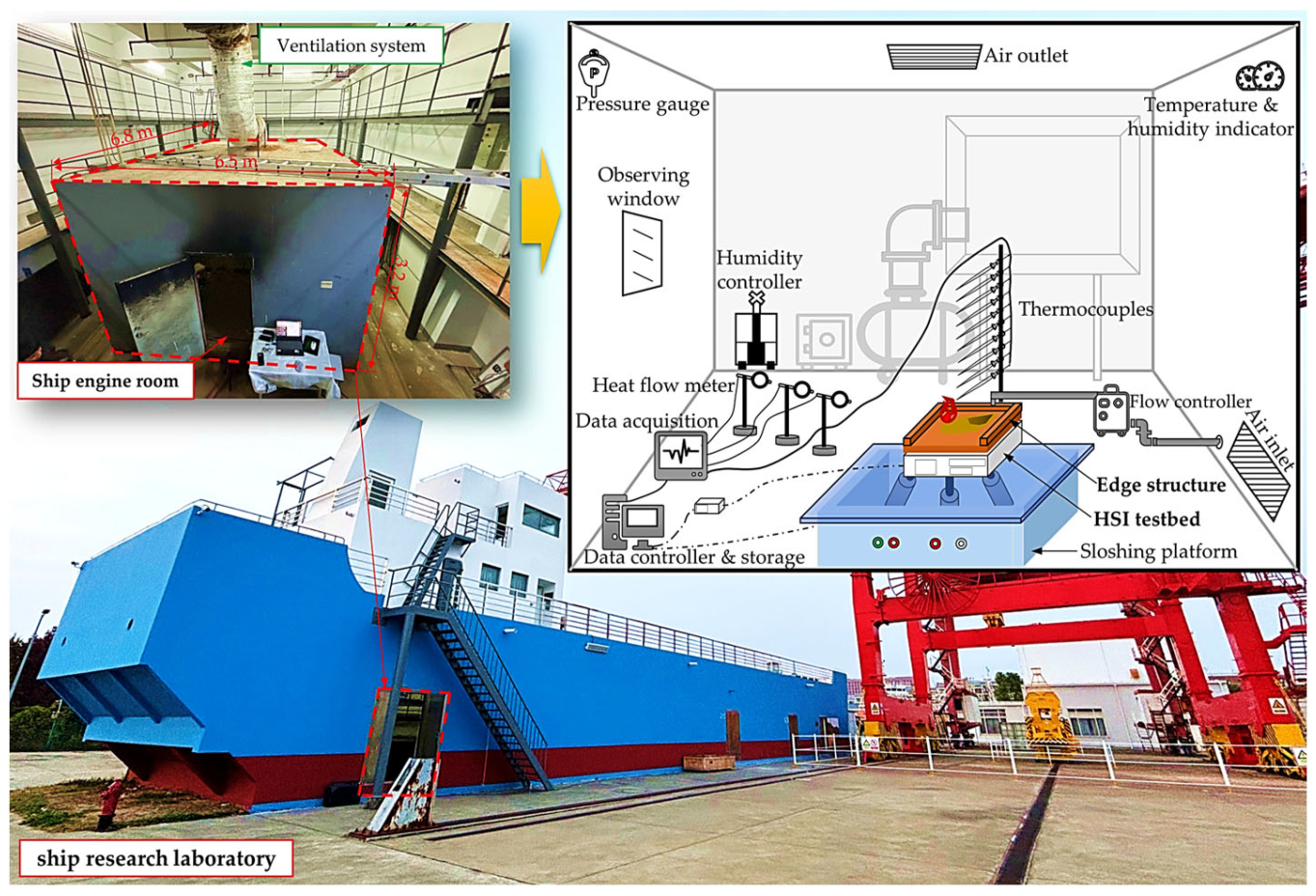
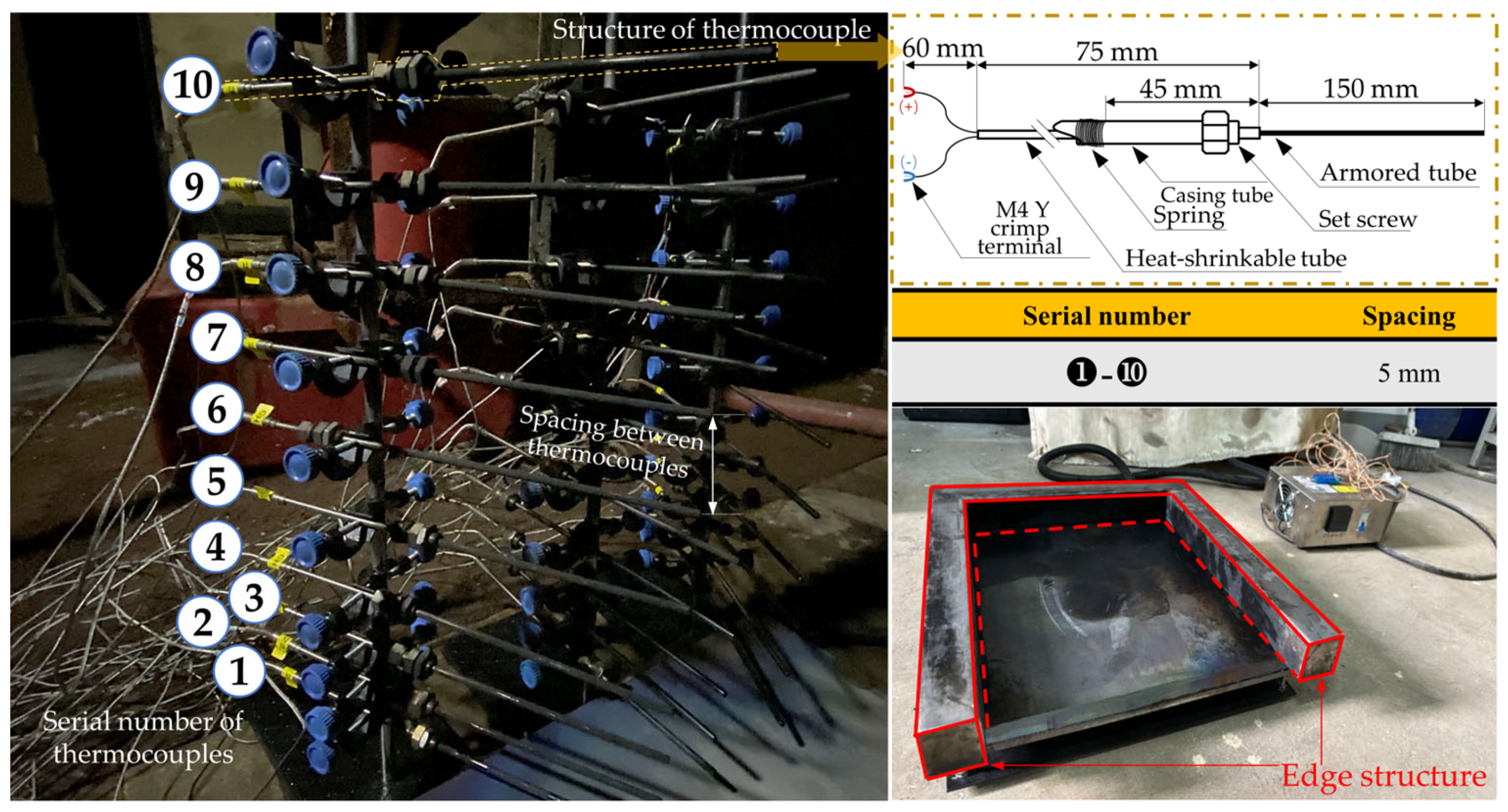

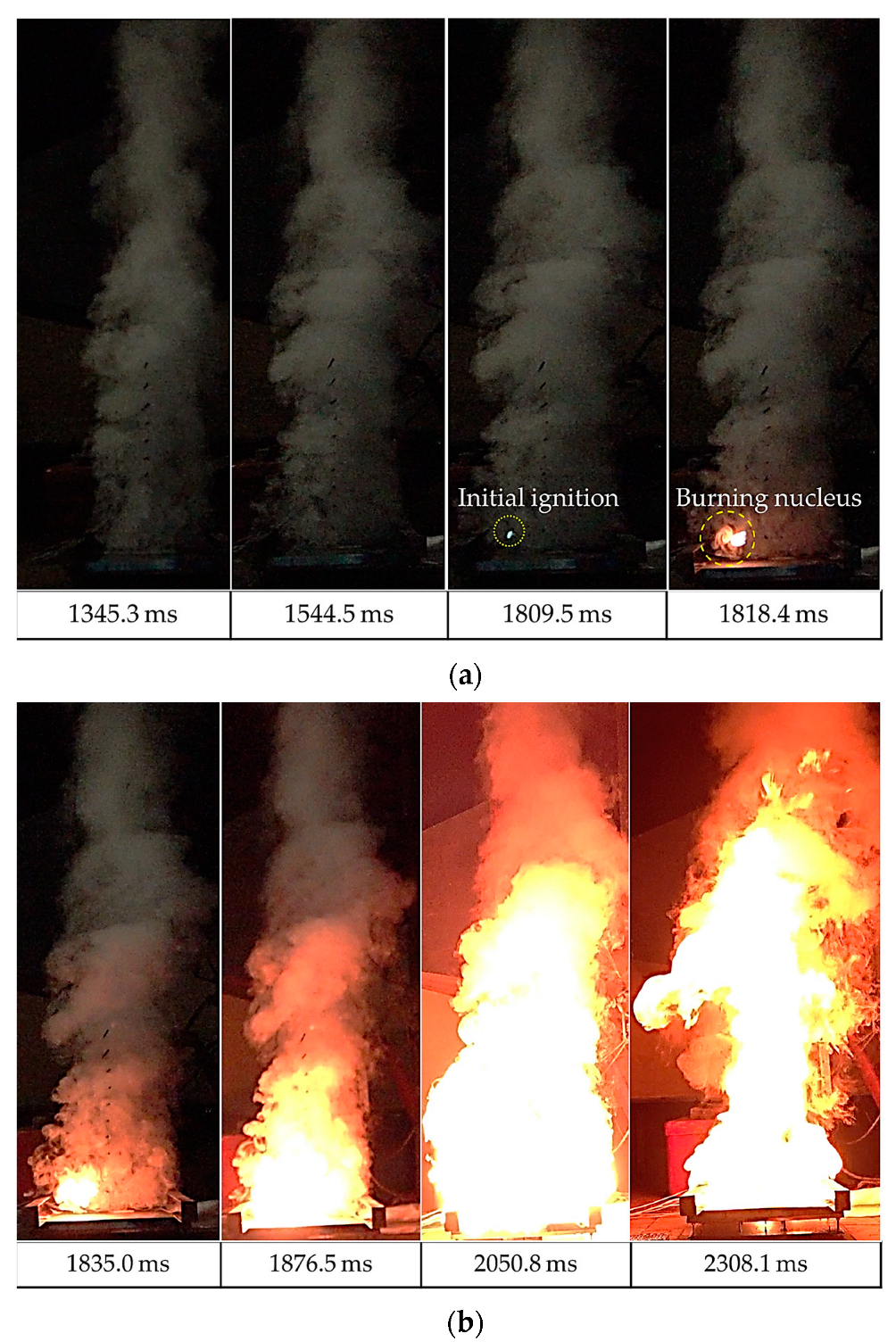
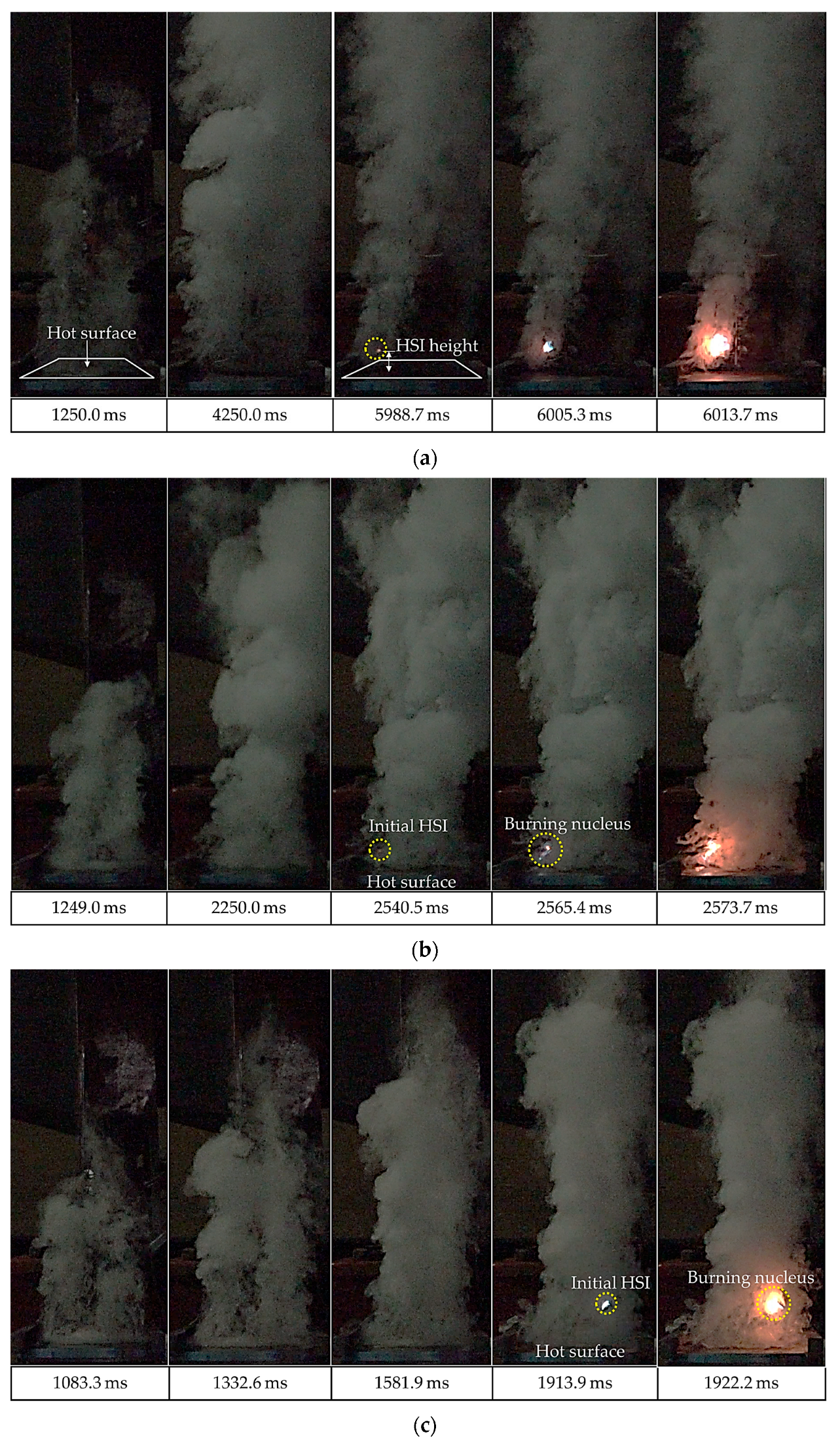
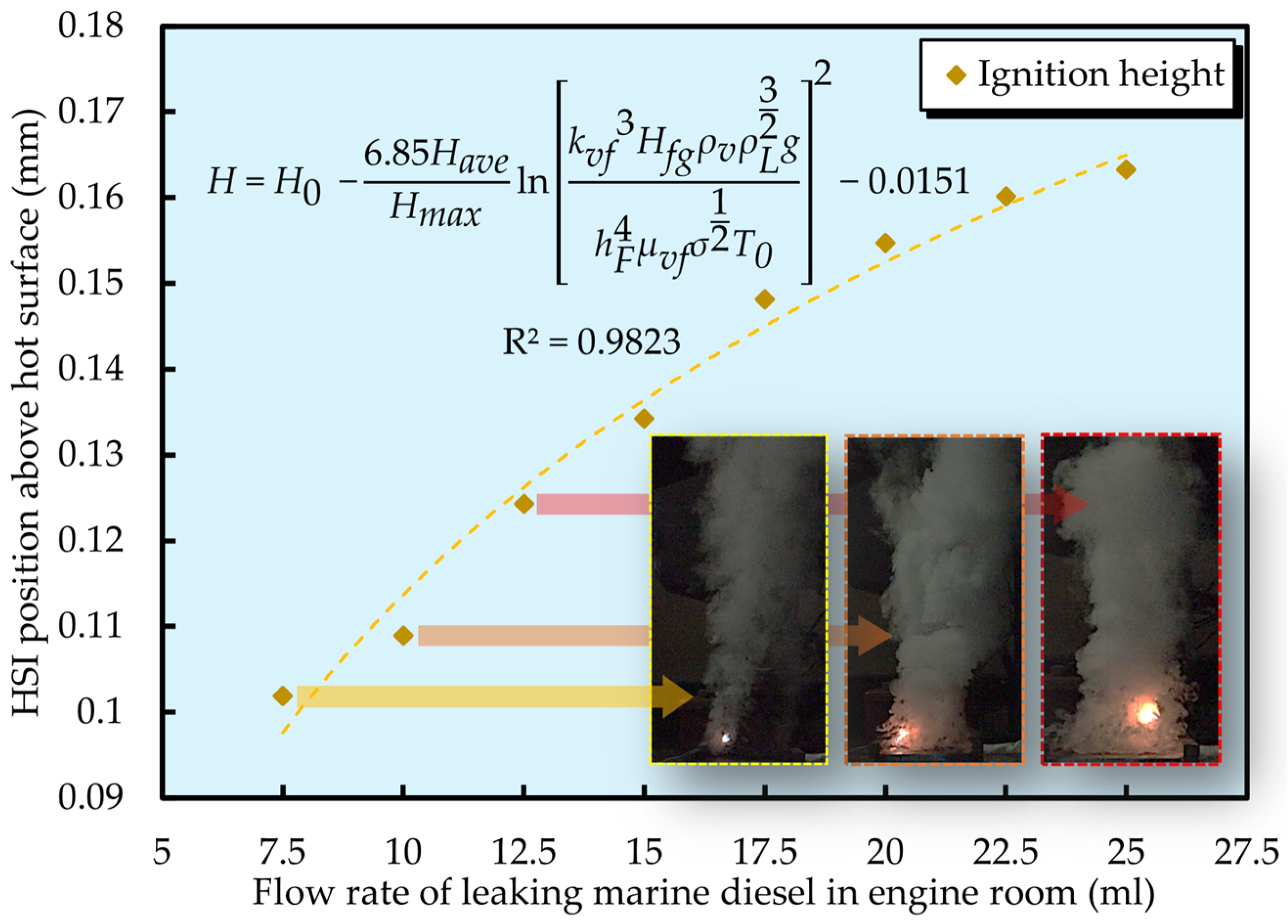
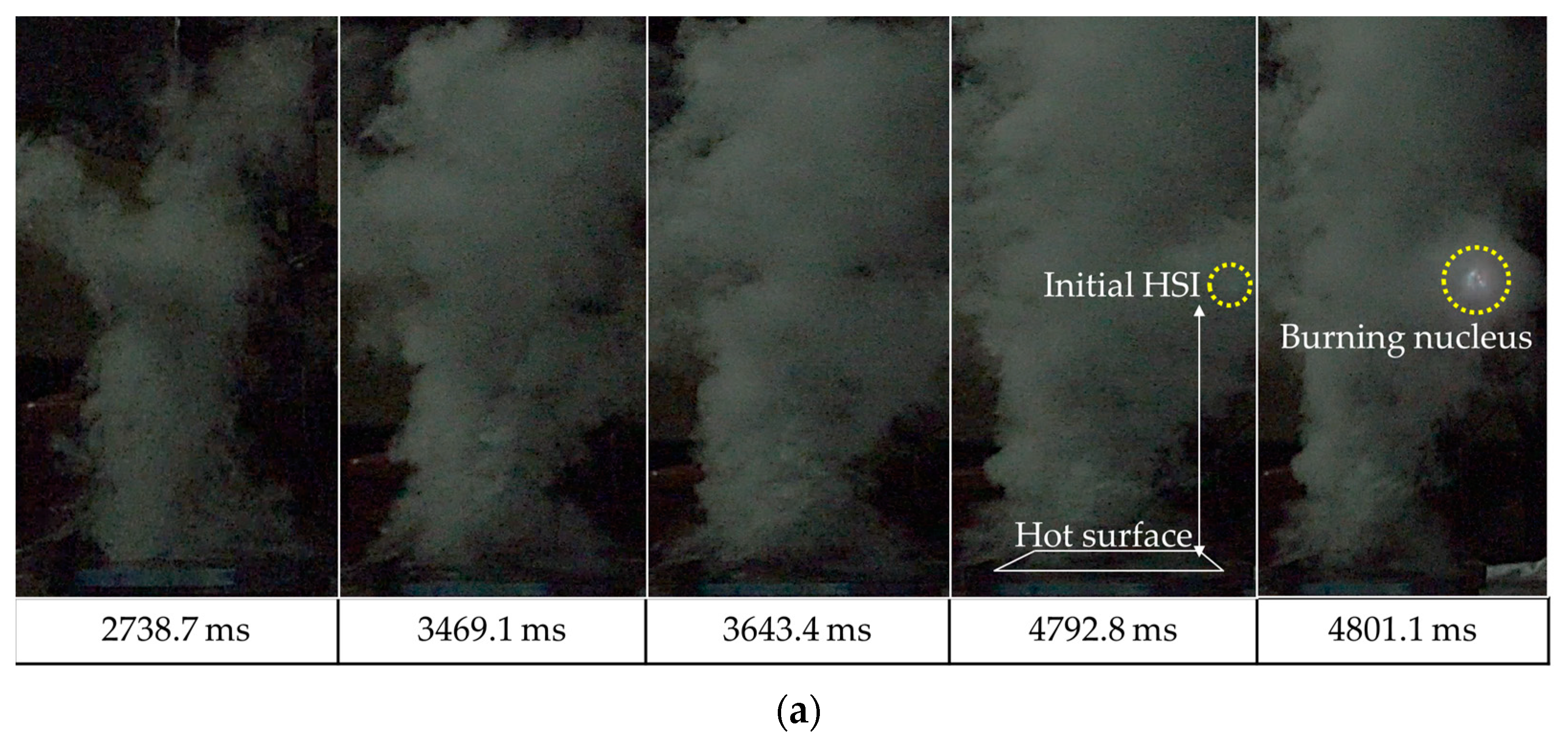


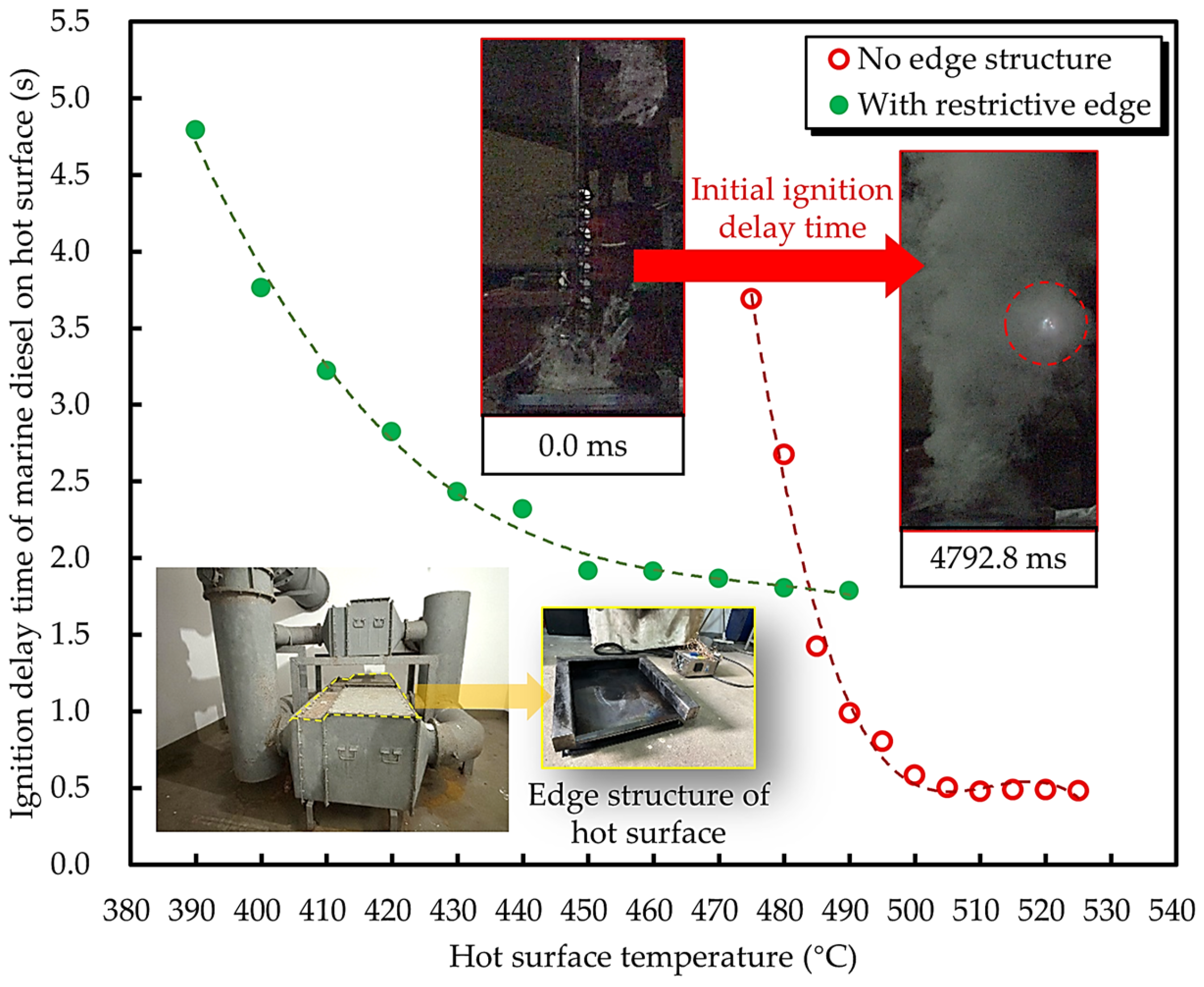
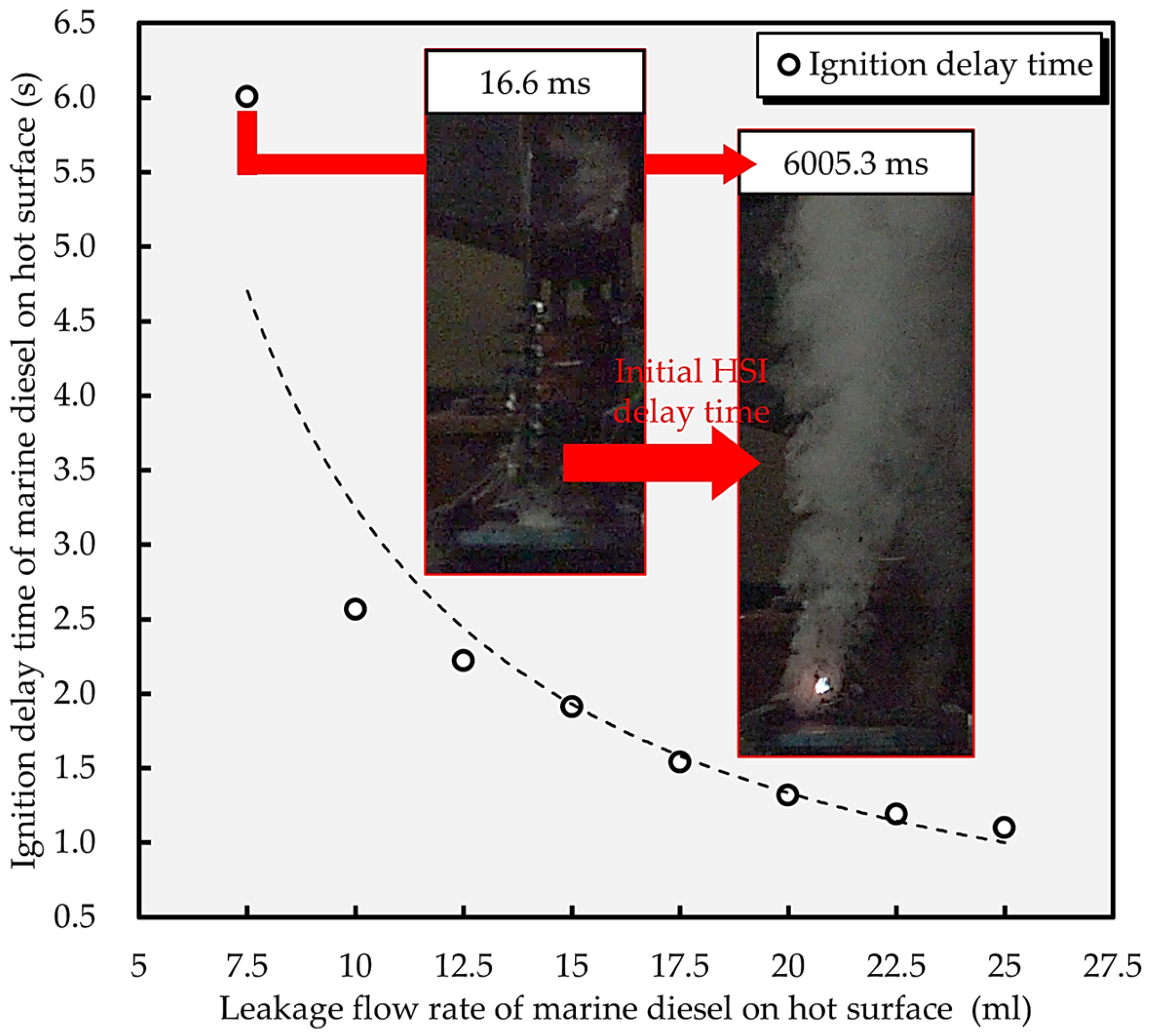


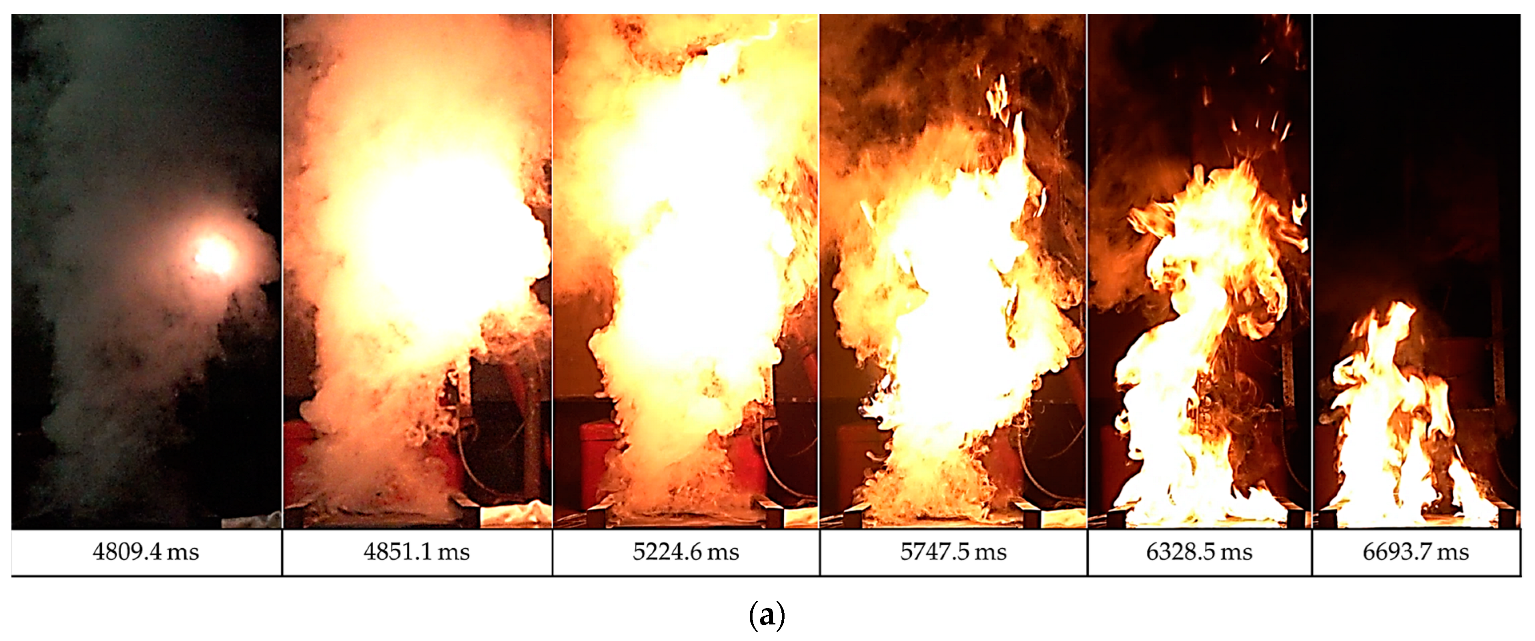
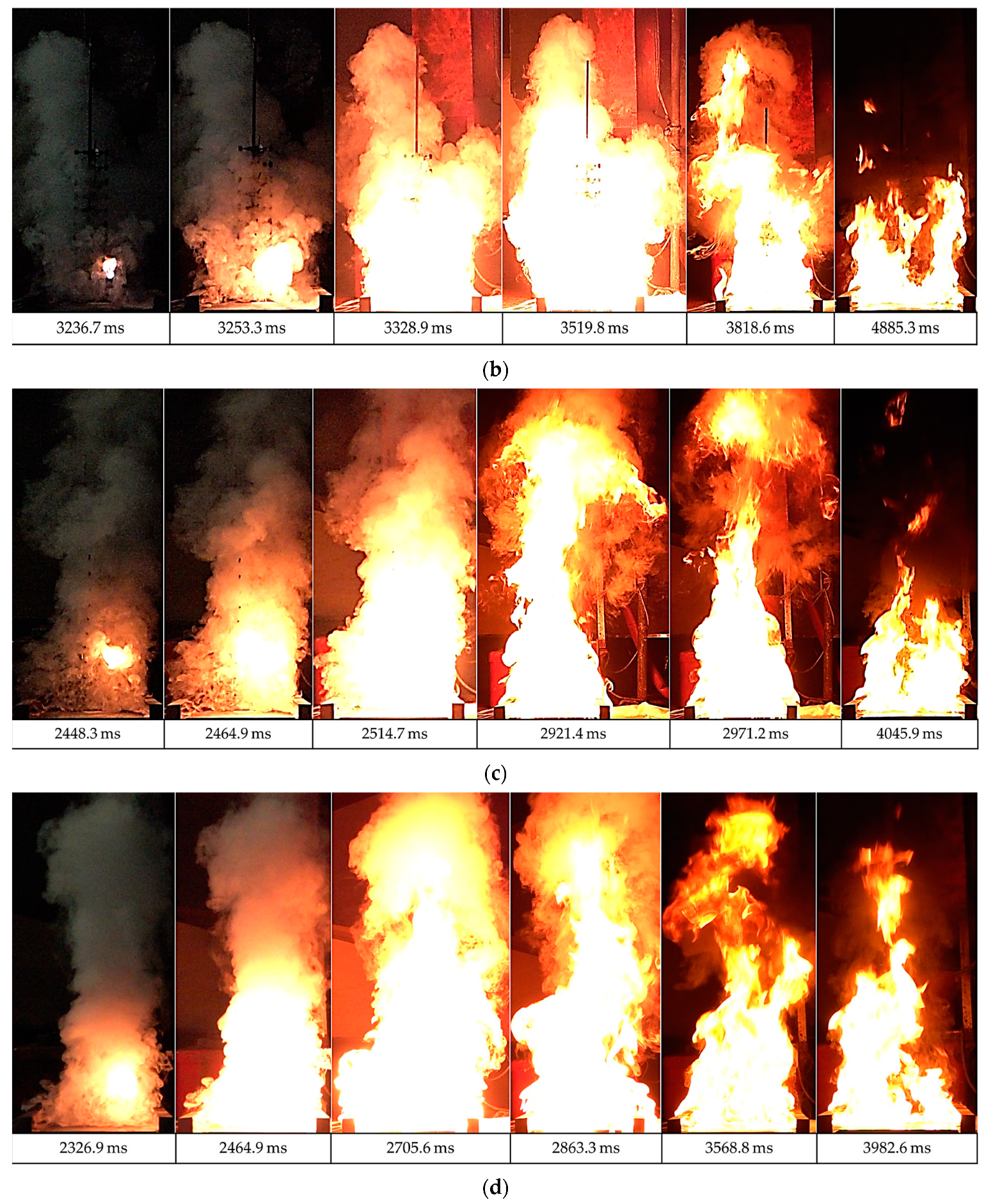
Disclaimer/Publisher’s Note: The statements, opinions and data contained in all publications are solely those of the individual author(s) and contributor(s) and not of MDPI and/or the editor(s). MDPI and/or the editor(s) disclaim responsibility for any injury to people or property resulting from any ideas, methods, instructions or products referred to in the content. |
© 2024 by the authors. Licensee MDPI, Basel, Switzerland. This article is an open access article distributed under the terms and conditions of the Creative Commons Attribution (CC BY) license (https://creativecommons.org/licenses/by/4.0/).
Share and Cite
Liu, X.; Wang, K.; He, Y.; Ming, Y.; Wang, H. Influence of Edge-Limited Hot Surfaces on Accidental Ignition and Combustion in Ship Engine Rooms: A Case Study of Marine Diesel Leakage. J. Mar. Sci. Eng. 2024, 12, 247. https://doi.org/10.3390/jmse12020247
Liu X, Wang K, He Y, Ming Y, Wang H. Influence of Edge-Limited Hot Surfaces on Accidental Ignition and Combustion in Ship Engine Rooms: A Case Study of Marine Diesel Leakage. Journal of Marine Science and Engineering. 2024; 12(2):247. https://doi.org/10.3390/jmse12020247
Chicago/Turabian StyleLiu, Xiaolei, Kan Wang, Yuru He, Yang Ming, and Hao Wang. 2024. "Influence of Edge-Limited Hot Surfaces on Accidental Ignition and Combustion in Ship Engine Rooms: A Case Study of Marine Diesel Leakage" Journal of Marine Science and Engineering 12, no. 2: 247. https://doi.org/10.3390/jmse12020247
APA StyleLiu, X., Wang, K., He, Y., Ming, Y., & Wang, H. (2024). Influence of Edge-Limited Hot Surfaces on Accidental Ignition and Combustion in Ship Engine Rooms: A Case Study of Marine Diesel Leakage. Journal of Marine Science and Engineering, 12(2), 247. https://doi.org/10.3390/jmse12020247






